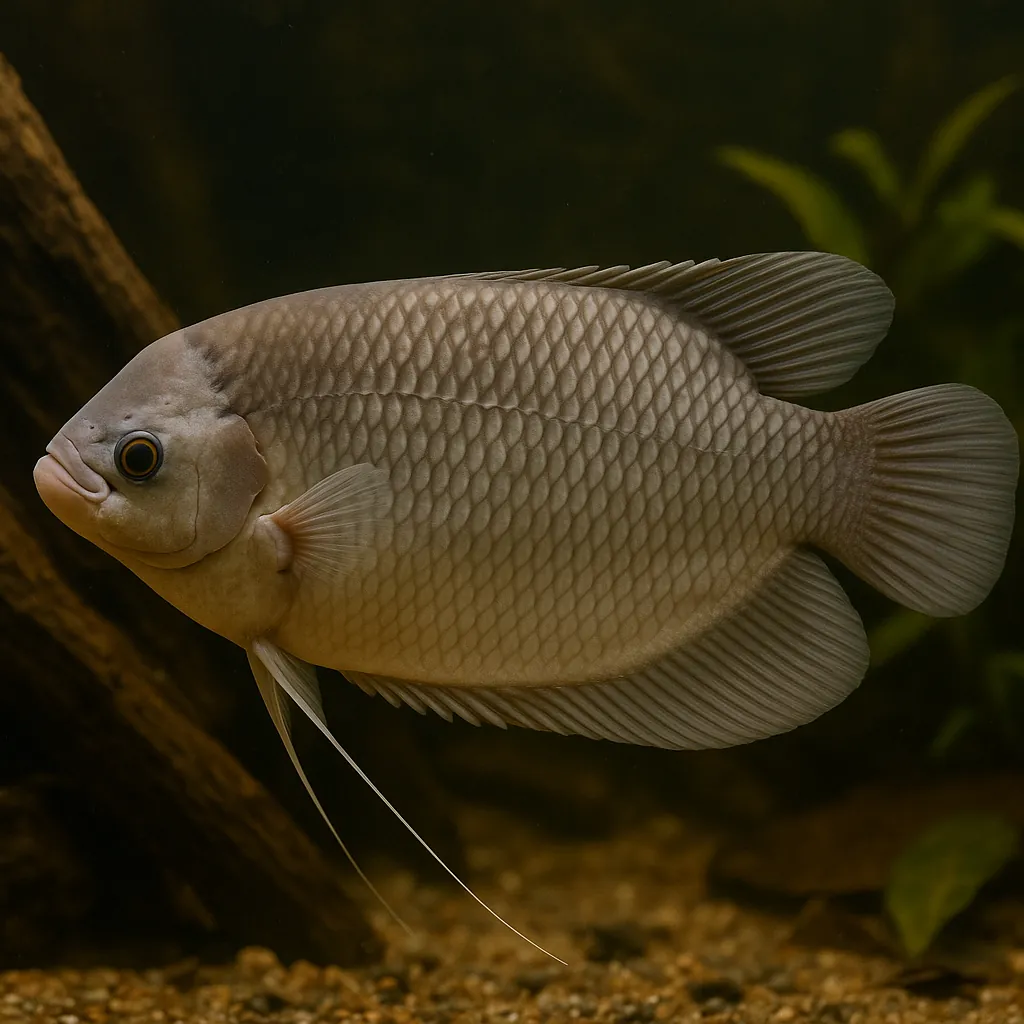
Giant gourami
Introduction
The Giant Gourami (Osphronemus goramy) is a captivating freshwater fish renowned for its impressive size and unique personality. Native to Southeast Asia, this species has become a favorite among aquarists seeking a long-lived and interactive pet. While their substantial growth and specific care requirements may pose challenges, dedicated fishkeepers find the experience of raising a Giant Gourami immensely rewarding.
What makes the Giant Gourami appealing to aquarists?
Beyond their striking appearance, Giant Gouramis are known for their intelligence and ability to recognize their owners, often displaying interactive behaviors that endear them to hobbyists.
Is the Giant Gourami suitable for beginner fishkeepers?
Due to their large size and specific care needs, Giant Gouramis are better suited for intermediate to advanced aquarists who can provide the necessary environment and attention.
Care and Environment
Proper care for a Giant Gourami involves meticulous attention to tank size, water parameters, diet, and habitat setup to ensure their health and longevity.
What is the minimum tank size required for a Giant Gourami?
A single Giant Gourami requires a minimum tank size of 200 liters to accommodate its growth and activity levels. However, a larger tank of at least 400 liters is recommended for optimal health and to house multiple individuals comfortably.
What are the ideal water parameters for Giant Gouramis?
Maintaining stable water conditions is crucial. The ideal parameters are:
- Temperature: 24°C to 30°C
- pH: 6.5 to 8.0
- Water Hardness: 5 to 25 dGH
Regular monitoring and adjustments are necessary to keep these conditions within the preferred ranges.
How should the tank be set up for a Giant Gourami?
Given their size and potential for aggression, the tank should be spacious with ample swimming room. Incorporate sturdy decorations like large rocks and driftwood to provide hiding spots. Live plants can be included, but be aware that Giant Gouramis may consume them; therefore, using hardy plant species or artificial plants is advisable.
What type of filtration and lighting is recommended?
A powerful filtration system is essential to handle the substantial waste produced by Giant Gouramis. Ensure the filter provides efficient mechanical and biological filtration without creating strong currents, as these fish prefer slow-moving waters. Moderate lighting is sufficient, with a regular day-night cycle to mimic natural conditions.
What should be included in a Giant Gourami's diet?
Giant Gouramis are omnivorous with a preference for plant-based foods. A balanced diet includes:
- High-quality pellets or flakes formulated for large omnivorous fish
- Fresh vegetables such as spinach, lettuce, and peas
- Occasional protein sources like live or frozen bloodworms, brine shrimp, and small fish
Feeding should occur twice daily, offering only what they can consume in a few minutes to prevent overfeeding and maintain water quality.
Are there any specific challenges in caring for Giant Gouramis?
One challenge is their rapid growth rate, which necessitates a large tank and robust filtration. Additionally, they can exhibit territorial behavior, especially during breeding, requiring careful monitoring and management of tank mates.
Origin and Habitat
Giant Gouramis are indigenous to Southeast Asia, inhabiting countries such as Indonesia, Malaysia, Thailand, and Vietnam. They are commonly found in slow-moving rivers, lakes, swamps, and flooded forests. These environments are characterized by warm temperatures, abundant vegetation, and soft substrates, providing ample hiding spots and feeding grounds.
What type of water bodies do Giant Gouramis inhabit in the wild?
They thrive in slow-moving or stagnant freshwater bodies like rivers, lakes, and swamps, often in areas with dense aquatic vegetation.
How do seasonal variations affect their natural habitat?
Seasonal flooding can expand their habitat, allowing them to access new feeding areas and breeding grounds, which influences their distribution and behavior.
Temperament and Compatibility
Giant Gouramis are generally peaceful but can display territorial behavior, particularly as they mature. They may become aggressive towards smaller fish or those with similar body shapes.
Can Giant Gouramis be kept with other fish?
Yes, they can coexist with other large, peaceful fish species. Suitable tank mates include large catfish, knifefish, and plecostomus. It's important to avoid housing them with significantly smaller fish, as they may be perceived as prey.
Do Giant Gouramis require companions of their own species?
They can be kept singly or in pairs. If housing multiple Giant Gouramis, ensure the tank is sufficiently large to prevent territorial disputes, especially among males.
How can aggression be minimized in a community tank?
Providing ample space, hiding spots, and visual barriers can help reduce aggression. Monitoring interactions and being prepared to separate individuals if necessary is also advisable.
Interesting Facts
Giant Gouramis possess several fascinating traits that make them stand out in the aquarium hobby.
Do Giant Gouramis recognize their owners?
Yes, they are known for their intelligence and can recognize their owners, often displaying interactive behaviors such as following movements outside the tank.
How do Giant Gouramis breathe?
They have a labyrinth organ, allowing them to breathe atmospheric air. This adaptation enables them to survive in low-oxygen environments by gulping air at the water's surface.
What is unique about their breeding behavior?
During breeding, males construct bubble nests using plant materials. After spawning, the male guards the nest and eggs, displaying heightened territorial behavior during this period.
Sources
All information in this article has been gathered from the following reputable sources:
Overview
Recommended Tank Size 105.7 Gallons (for optimal health and to house multiple individuals comfortably) |
Minimum Group Size 1 |
Minimum Tank Volume 52.8 Gallons |
Maximum Adult Length 27.6 inches |
Average Adult Length 19.7 inches |
Shoaling (6+ required) No |
Preferred Water Type Freshwater |
Temperature Range (°C) 24–30 |
pH Range 6.5–8.0 |
Water Hardness (dGH) 5–25 |
Typical Lifespan (years) 10 years |